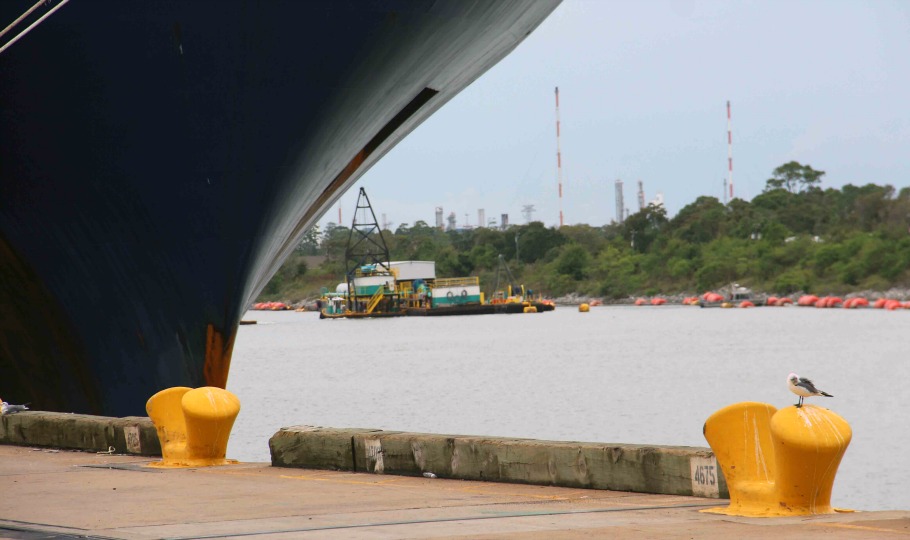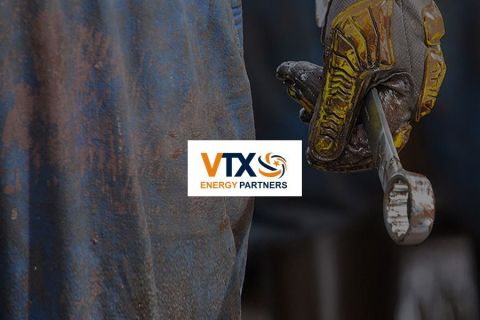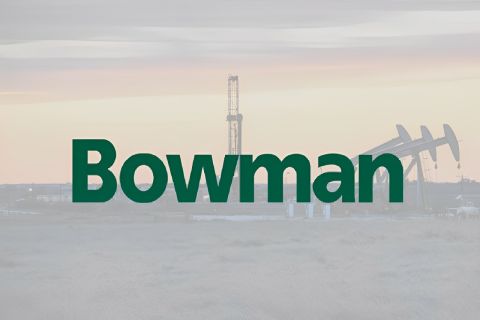
Wind whips the U.S. flag on a vessel traversing the Port of Houston. Source: Hart Energy
Sunlight dances across the slate gray waters of the Houston Ship Channel, but only briefly. In the next moment the mass of charcoal-gray clouds dominating the horizon reasserts itself and raindrops pelt the darkened waves.
But not for long. Swiftly, the sun returns and the channel calms. Volatile weather as metaphor for energy markets fits the perspective of an industry riding waves of fortune, confident of being a single achievement away (we’ve unlocked the Marcellus!) from controlling its journey yet anxious about storms lurking just beyond the horizon.
But if the way clear of low commodity price doldrums remains murky, there is confidence that the waters spanning the globe provide an answer. From Gulf Coast terminals, tankers laden with the bounty of the North American shale boom depart more and more frequently, and with the opening of expanded lanes in the Panama Canal, larger ships will open up Asian markets for competition from U.S. players.
In-Depth Changes
 The key is not just the size of the canal’s new lane, but the size of the ships that can now traverse it.
The key is not just the size of the canal’s new lane, but the size of the ships that can now traverse it.
“The depth [from 40 feet to 50 feet] has really helped expand the capacity overall,” Greg Haas, director of integrated energy research at Stratas Advisors, told attendees of Hart Energy’s Midstream Texas conference in September. “What that does is open up more economic shipping. You can get from one side of the ocean to the other without going down and around Cape Horn or, alternately, going down and around the continent of Africa and back up. These savings are weeks in some cases, and therefore you’re cutting time on shipping charges and getting products to market quicker.”
How much time and money can be saved? Haas studied the impact on LNG tankers.
From the Gulf Coast to Asia, a ship would typically take about 80 days to move east from the Gulf of Mexico, across the Atlantic and around the Cape of Good Hope to deliver its cargo, then back again. Travel west through the Panama Canal and it’s a 50-day round-trip journey with total savings of about $900,000, Haas said.
To break it down, that’s 25 cents to 30 cents per million British thermal units, a cost savings that is not restricted to U.S. exporters. A competitor in Peru, for example, can cut the time at sea from 47 days to 32 by shipping LNG through the canal instead of around Cape Horn.
Exports Begin At Home
 But not all exports are destined for other continents. While North American neighbor Mexico has enacted an energy reform that has smoothed the way for numerous natural gas pipeline projects, it remains an importer of LNG at its Pacific Coast Manzanillo terminal in the country’s central region.
But not all exports are destined for other continents. While North American neighbor Mexico has enacted an energy reform that has smoothed the way for numerous natural gas pipeline projects, it remains an importer of LNG at its Pacific Coast Manzanillo terminal in the country’s central region.
Technical issues have plagued the Los Ramones Phase II South Pipeline, which was commissioned in July and expected to deliver up to 1.43 billion cubic feet per day (Bcf/d) to the area that includes Mexico City, the U.S. Energy Information Administration (EIA) said in a recent report. The line has only been able to operate at 400 MMcf/d, creating a shortfall.
LNG imports at Manzanillo increased by an average of 30% in the second and third quarters of 2016 compared to the same periods in 2015, and by 62% in October, the EIA said, citing research by IHS.
Read: Mexico's Energy Reform: How Howard Energy's Projects Define Success
Here again, the expanded Panama Canal demonstrates its expanded influence. The one-way trip from Cheniere Energy Inc.’s (NYSE MKT: LNG) LNG facility at Sabine Pass, La., to Manzanillo via the canal cuts 17 days off the 27-day transit around Cape Horn, the EIA said. The expansion has allowed LNG exporters from the U.S., as well as Trinidad and Tobago and Algeria, to supply a terminal that was once exclusively supplied by Peru.
Ethane In Demand
What intrigues Haas is what else will be shipped through the expanded lanes of the Panama Canal. Specifically, he’s watching for ethane and propane.
 “Ethane will certainly continue to ramp up simply because we’ve been rejecting ethane over the years but now we’re going to either export it or convert it into petrochemicals, and the demand for it will pull the barrels out of the gas stream,” he said.
“Ethane will certainly continue to ramp up simply because we’ve been rejecting ethane over the years but now we’re going to either export it or convert it into petrochemicals, and the demand for it will pull the barrels out of the gas stream,” he said.
Propane, however, has not been rejected, Haas said. He sees a tightening of export availability that corresponds to reduced drilling in wet gas plays, and doesn’t expect a recovery until the middle of the next decade.
U.S.-produced ethane, though, is set to sail. European and Asian petrochemical manufacturers have a number of feedstocks available: ethane, propane or naphtha. But propane supply will be tight and naphtha’s price is tied to the price of crude oil.
“By utilizing U.S. ethane, the European makers of petrochemicals and the Asian makers of petrochemicals can save 10 to 20 cents of the margin and costs by utilizing U.S. feedstocks vs. naphtha, and the Panama Canal helps make that happen if they were to go to Asia.”
This course will be charted by economics. Freed of export constraints by Washington, U.S. energy shippers can compete worldwide in oil and gas markets, backed by vast shale plays and the technology to exploit shale gas profitably.
It’s just a matter of bringing that product to the right customer at the right price. And the customer is across the water.
Joseph Markman can be reached at jmarkman@hartenergy.com or @JHMarkman.
Recommended Reading
VTX Energy Quickly Ramps to 42,000 bbl/d in Southern Delaware Basin
2024-09-24 - VTX Energy’s founder was previously among the leadership that built and sold an adjacent southern Delaware operator, Brigham Resources, for $2.6 billion.
US Drillers Cut Oil, Gas Rigs for Third Week in a Row
2024-10-04 - The oil and gas rig count fell by two to 585 in the week to Oct. 4.
EY: How AI Can Transform Subsurface Operations
2024-10-10 - The inherent complexity of subsurface data and the need to make swift decisions demands a tailored approach.
Bowman Consulting to Manage, Monitor Delaware Basin Wells
2024-10-14 - Bowman Consulting Group’s scope of work includes conducting detailed field surveys of above-ground infrastructure assets across well sites of up to to 8 acres.
E&P Highlights: Oct. 7, 2024
2024-10-07 - Here’s a roundup of the latest E&P headlines, including a major announcement from BP and large contracts in the Middle East.
Comments
Add new comment
This conversation is moderated according to Hart Energy community rules. Please read the rules before joining the discussion. If you’re experiencing any technical problems, please contact our customer care team.





